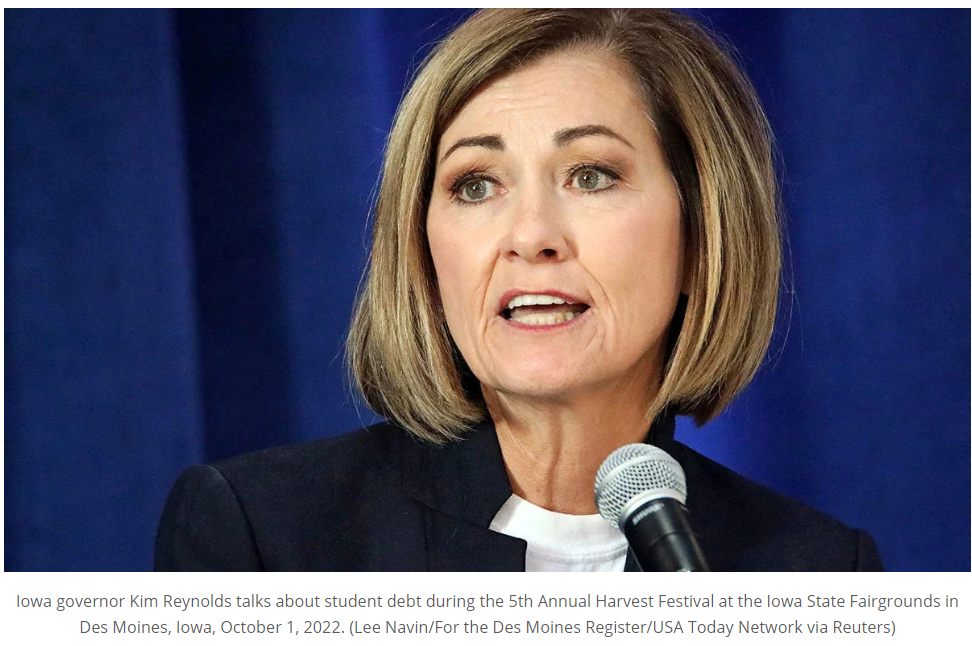|
Iowa’s fiscal foundation remains strong despite national economic uncertainty because of the state’s fiscal conservatism and prudent budgeting.
Governor Kim Reynolds has made Iowa a leader in conservative fiscal policy. This approach has already left more money in taxpayers’ pockets, and set the state on course to implement a low, flat income tax by 2026. In its Fiscal Policy Report Card on America’s Governors for 2022, the Cato Institute “grades governors on their fiscal policies from a limited-government perspective.” On this basis, Cato ranked Governor Reynolds as the best in the nation, writing that she “has been a lean budgeter and dedicated tax reformer since entering into office in 2017.” Last year, Governor Reynolds and the Iowa legislature continued to place a priority on prudent budgeting. The $8.2 billion budget for fiscal year 2023 represented a mere 1 percent increase from the prior year. And for FY 2024, Reynolds has proposed an $8.5 billion budget, with the extra funds meant to cover the universal school-choice plan that the legislature recently passed. Iowa’s anticipated $1.6 billion budget surplus for FY 2023 is nearly as much as the $1.9 billion surplus recorded in FY22, with another $2.2 billion surplus expected in FY 2024. The state should have $895.2 million in reserve funds in FY 2023 and $962.5 million in FY 2024 — the statutory maximum for those years. The state’s Taxpayer Relief Fund — the fund into which excess tax revenue is placed so that it can be returned to taxpayers by the legislature — was worth $1.1 billion in FY 2022, and is on track to grow to $2.7 billion in FY 2023 and then to $3.4 billion in FY 2024. In 2022, Iowa also enacted the most comprehensive income-tax-reform package in the nation. Over four years, the nine-bracket income tax will transform into a flat income tax with a 3.9 percent rate. The corporate tax has also already been reduced from 9.8 percent to 8.4 percent, and is set to gradually shrink until it reaches a flat 5.5 percent rate. These measures constitute a sound, pro-growth tax policy that will create incentives to work, save, and invest, and will make Iowa’s economy more competitive on the national stage. Prudent budgeting is essential for ensuring that these income-tax cuts can be responsibly implemented. And on Governor Reynolds’ watch, Iowa’s tax revenues continue to grow, reducing the degree to which the tax cuts must be “paid for” through spending cuts. The most recent numbers, released in February, showed that revenues are at $35.9 million, or 5.7 percent higher than they were at the same time last fiscal year. That said, in addition to proposing a fiscally prudent FY 2024 budget, Governor Reynolds is also proposing to rein in Iowa’s administrative state. It has been 40 years since Iowa made any major reforms to state government, and in that time the size and scope of government have increased. Reynolds is proposing to streamline the executive branch and reverse some of that growth. Currently, Iowa has 37 cabinet agencies. The governor’s proposal calls for a 16-agency cabinet. She argues that government is both too big and too expensive, and streamlining it will result in more efficiency and better services for taxpayers. She estimates that if enacted, this consolidation plan would save taxpayers over $214 million in the next four years. Although Governor Reynolds and the legislature have placed a priority on prudent budgeting, there is more that could be done. Iowa statute currently allows legislators to spend up to 99 percent of projected tax revenues. This rule should be replaced with one that would limit most spending to the rate of population growth plus inflation, which could have saved Iowans as much as $2.9 billion — or $3,700 for the average family of four — in taxes had it been in place since 2013. Meanwhile, Governor Reynolds has already signaled that she does not want to stop at a flat income-tax rate of 3.9 percent. She has said she aims to lower the rate to a flat 2 percent, and to eventually eliminate the tax altogether while continuing to cut state-government spending. Governor Reynolds should be applauded for putting Iowa on the path to a robust economy, and providing a model of sound fiscal policy for the federal government and other states to emulate. Now, she just has to keep at it, because there is more work still to be done. Originally published at National Review Online.
0 Comments
Leave a Reply. |
Vance Ginn, Ph.D.
|


 RSS Feed
RSS Feed